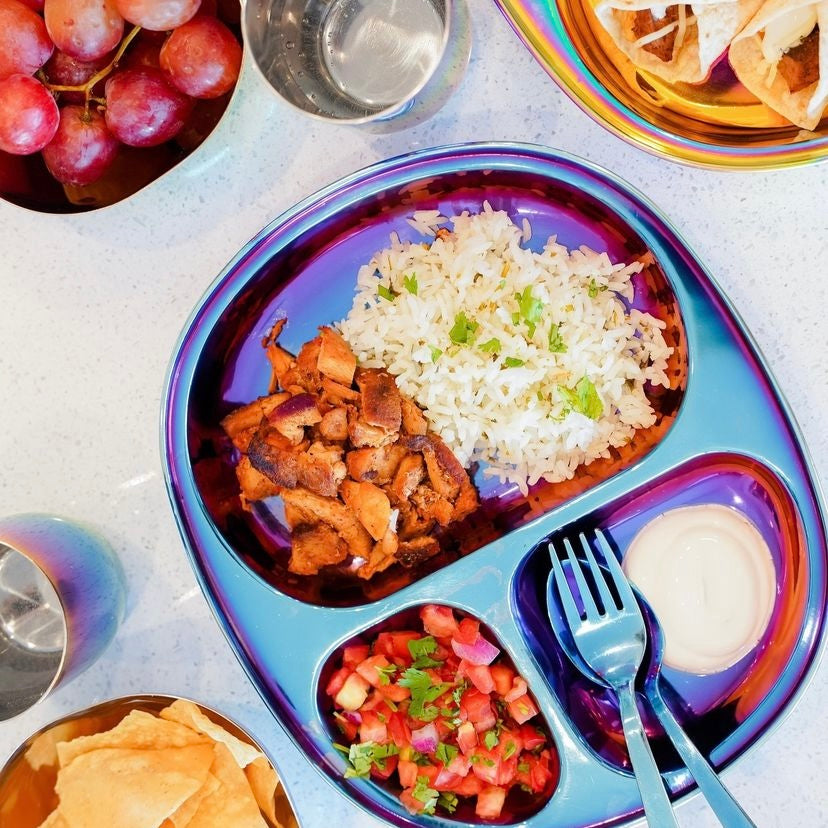
Introducing flavors across the world - the science behind raising an adventurous eater
|
|
Time to Read: 6 min
|
|
Time to Read: 6 min
Gustation. It’s a fun word right? It is the scientific term for “taste.” We know that there are 5 basic tastes: sweet, sour, bitter, salty and unami (savory). We actually have receptors in our oral cavity (mouth) and gut to sense taste - they help tell us if we should allow a substance into our body. The human body is pretty amazing and we were born with abilities to keep ourselves safe. For example, we prefer sweet over bitter because well - breast milk is sweet and poison is bitter. See - our taste buds have helped us grow and thrive for centuries.
Flavor is different - it’s actually an integration of taste, smell and texture. Millions of combinations of these three inputs allow us to experience a wide array of flavors. In fact, over 70% of what we experience during dining comes from smell! There are some common flavors among various cultures. When you think of Indian food for example - you may think of bold and spicy. When you think of French food perhaps you smell the sweetness of freshly baked croissants. When you think about Chinese food - cheese doesn't often come to mind. Some tastes are more common in certain regions of the world than others.
Founded by a pediatrician and mom of three
Stainless steel is the only kid-friendly material recommended by the American Academy of Pediatrics
We are guided by a Scientific Advisory Council comprised of environmental and medical experts, guiding us in creating the safest products, following the latest science and promoting policy to protect human health and our planet
Want to know more? Check out our story and our products.
These preferences are influenced by a variety of factors like genetics, culture, repeated exposures and modeled behavior. Our dietary experiences as infants are extremely important in shaping our food preferences. In fact, this starts when a baby is in utero - the flavor molecules make it from mom’s diet into the amniotic fluid and after the baby is born, into the breast milk. My first hand experience? Asian Pears. I craved and ate these religiously during both pregnancies and my children can confidently say their favorite fruit is … yup, asian pears.
In fact, babies form taste patterns by 9 months but they also change over time. During early childhood, infants are more likely to accept new foods, so promoting a varied diet and curiosity towards foods decreases the likelihood of picky eating in toddlerhood. Developing this love of adventurous eating should start from the initial stages of the food journey as parents introduce solids. After the age of 3–4 years, dietary patterns/food habits remain more stable, so starting early is crucial!
There are plenty of examples of food that is acceptable to one culture but completely novel to another culture. Corn fungus (Mexico), developing bird embryos (Philippines), a giant rat (Togo), and jellied eels (UK) are all examples that were shown in National Geographic when discussing foods across the world. Children raised in China experience many more textures than children raised in the USA. In Ethiopia beans are roasted and passed around to smell the aroma as part of the dining experience. So, the form of preferences for certain tastes, textures and smell stem from the culture we are raised in - our preferences start in our home.
So, how can you raise an adventurous eater who experiences flavors across the world?
So while you may not be introducing squid at your next family dinner, you can slowly but surely start your adventure across the world through mealtime. Cheers to happy healthy eating friends!
The American Academy of Pediatrics (AAP) released a report in July 2018 suggesting ways that families can limit exposure to certain chemicals at mealtime, including “the use of alternatives to plastic, such as glass or stainless steel, when possible.” The report explained that “…some additives are put directly in foods, while “indirect” additives may include chemicals from plastic, glues, dyes, paper, cardboard”. Further, “Children are more sensitive to chemical exposures because they eat and drink more, relative to body weight, than adults do, and are still growing and developing.” While stainless steel items meet the recommendation to avoid plastic products in children, Ahimsa® products have the obvious advantage of not breaking like glass.
According to the Steel Recycling Institute, steel can be recycled over and over and over again without losing its integrity and requires less energy to recycle than to make anew. Most plastic unfortunately ends up in landfills and it is estimated to take 700 years to decompose. Our special coloring process that allows Ahimsa® products to be fully metal is environmentally friendly, so it does not produce toxic run-off into the ecosystem.
No. Our steel is durable, so it won’t break or shatter with everyday use, like glass. And it won’t peel, like other colored stainless steel products you’ve seen. We use a special process that allows the colors to naturally occur in the metal.
Our products are meant to last, you can use Ahimsa at ages 1, 8 and 18! We thoughtfully design our products to be safe for little ones and our planet while reducing consumption. Once your child outgrows the Starting Solids Set and can use regular cups and utensils, the training cup is the perfect size rinse cup in the bathroom, the infant spoon doubles as a tea stirrer and the bowl is great for snacks or as an additional compartment to our modular divided plate. Our plates are great for any age as they encourage choosing a variety of healthy foods at each meal and help visualize portion sizes easily. It’s the lasting beauty of stainless steel - grows with your child and reduces waste.

